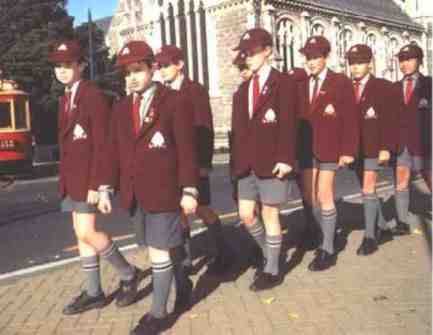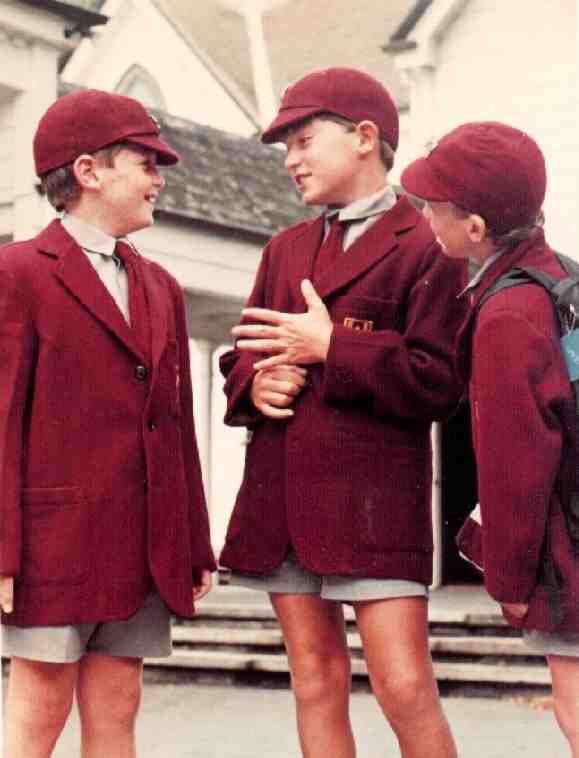
Figure 1.--Traditional English school caps were widely worn at New Zealand secondary schools into the 1950s. They are now worn at only a few traditional preparatory schools. These boys are wearinf their schools winter uniform.


Figure 1.--Traditional English school caps were widely worn at New Zealand secondary schools into the 1950s. They are now worn at only a few traditional preparatory schools. These boys are wearinf their schools winter uniform. |
One of the most widely worn school uniform garments worn through the 1950s was the peaked cap. It was so common in the early 20th Century that it was adopted as the Cub Scout cap by Boy Scouts in England and around the world. The cap appeared first in England during the mid-19th century and then spread around the world, but of course was most common at schools in Empire countries. The cap began to decline in the 1950s as heargear in general mwas beginning to be less commonly worn. In the 1960s the cap disappeared at most New Zealand schools, except for traditional preparatory schools. By the 1990s only a few prep schools still required it.
The peaked school cap was introduced in New Zealand schools as part and parcel of the British education system. I'm not sure just when it was introduced, presumably in the late 19th century. Virtually all secondary school boys were wearing them by the turn of the century. They were less common in primary schools as uniforms were not required.
I have the impression that New Zealand school caps were mostly solid colors
and were not as diverse as was the case in England. This is based, however, on the kinited number of historical photographs that I have seen. I could be wrong about this.
New Zealand state elenentary schools have not required school uniforms.
Thus elementary-age school boys did not have to wear caps. The school cap was a common style for boys. Thus in an era that caps were much more common than is the case today, it is likely that even many elementary pupils wore them.
Most state secondary schools did have very strict uniform standards. As in England, a freestate secondary school system did not develop until after World War II. Most boys finished their eduvation when they completed elementary schools. The fee paying secondary schools that did existed catered to boys from affluent families. Most emulated English public schools and required uniforms. Almost all of them included the English peaked school cap as pat of the uniform. This continued
through the 1950s.
New Zealand has a large Irish Catholic population. The Irish were understandably concerned with the anti-Catholic bias of the English protestant educational establishment. Catholic elementary schools, unlike the state elementary schools, have required uniforms. I'm not sure, however, just when the catholic schools began requiring uniforms. I'm also not sure if this ever included caps. The Catholic elementary schools in 1980s did not requireccaps. The uniform regulations at the Catholic secondary schools, however,
did commonly include caps through the 1950s.

Figure 2.--This is one of the few other New Zealand schools still requiring boys to wear a school cap. These boys wear the summer uniform. Click on the image for a close up of the cap. |
Patterns concerning caps vary somewhat at private elementary (as in Engand called preparatory schools) and secondary schools.
Preparatory schholsNew Zealand preparatory schools all required caps through the 1960s. These schools were run like English preparatory schools including many English staff and head masters. They adopted the uniform worn at English preparatory schools and the uniforms until light-weight cottoshorts and Roman sandals were introduced, was virtually indistinguishable from English uniforms. The schools began to drop caps in the 1970s. Only a few schools now requirev the traditiinal peaked cap. Some schools out of concern with the
depletion of the ozone layer and increasing indices of skin cancerare introducing baseball caps.
Secondary schools: Most private secondary schools required caps through the 1950s. This did not begin to change until the 1960s. Today none of the secondary schools require
caps, although they are still worn as part of a cricket uniform.
Related Cap Pages in the Boys' Historical Web Site
[Main school uniform cap page]
[Main cap page]
[Australian caps]
[English caps]
[Japanese caps]
[New Zealand caps]
[Scottish caps]
Navigate the Relate Boys Historical Clothing Uniform Garment Pages
[Main garment page]
[Blazers]
[Bookbag]
[Caps]
[Coats]
[Hose]
[Kilts]
[Pants]
[Shirts]
[Shoes]
[Smocks
[Suits]
[Seaters]
[Ties]
